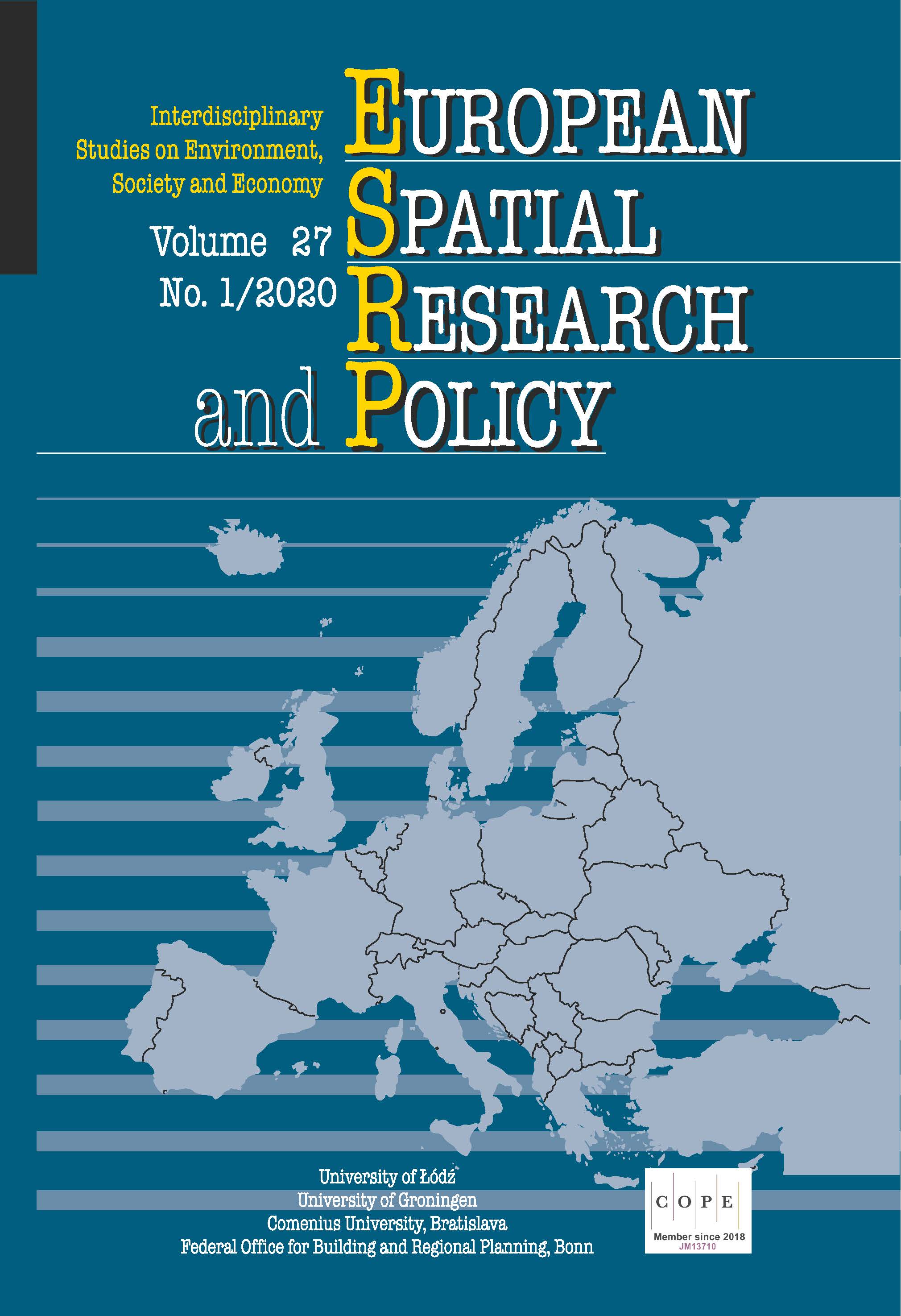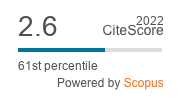The Mortality Structure of Populations the Demographic and Socio-Economic Situation in European Union Countries: Development and Differentiation in the Period 2011–2014
DOI:
https://doi.org/10.18778/1231-1952.27.1.08Keywords:
demographic and socio-economic indicators, cause-specific mortality, composite indicator, European population comparisonAbstract
The purpose of the study is to compare the differentiation of the demographic and socio-economic indicators and the structure of mortality of the population in EU countries in the period 2011–2014. The composite indicator of mortality structure revealed the most favourable situation in Finland (134.4%), while the worst situation was found in Hungary (63.8%). The best demographic and socio-economic situation was found in Luxembourg (165.4%) and the worst in Hungary (64.9%), Greece (65.9%) or Lithuania (67.3%). The regression model equation shows that the mortality structure is strongly affected by the variables of life expectancy at birth and education. It is evident that there was a differentiation in the demographic and socio-economic indicators in EU countries in the period 2011–2014, while there was no unambiguous trend of the convergence of the mortality structure among EU countries.
Downloads
References
AKTAŞ, M.T. (2017), ‘Comparing EU Countries, Turkey and Macedonia via Clustering Analysis for Quality of Life Indicators’, [in:] KOÇ S., ÖRUÇ E. and ANLAR A. (eds.), Economic Issues: Crises, Finance and Agriculture. London IJOPEC Publication, pp. 76–104.
Google Scholar
ALBERT, C. and DAVIA, M.A. (2011), ‘Education is a key determinant of health in Europe: a comparative analysis of 11 countries’, Health Promotion International, 26 (2), pp. 163–170. https://doi.org/10.1093/heapro/daq059
Google Scholar
BÖRSCH-SUPAN, A., BRANDT, M., HUNKLER, Ch., KNEIP T., KORBMACHER J., MALTER, F., SCHAAN, B., STUCK, S. and ZUBER, S. (2013), ‘Data Resource Profile: The Survey of Health, Ageing and Retirement in Europe (SHARE)’, International Journal of Epidemiology, 42 (4), pp. 992–1001. https://doi.org/10.1093/ije/dyt088
Google Scholar
BRANDT, M., DEINDL, Ch. and HANK, K. (2012), ‘Tracing the origins of successful aging: The role of childhood conditions and social inequality in explaining later life health’, Social Science and Medicine, 74 (9), pp. 1418–1425.
Google Scholar
CASELLI, G., VALLIN, J. and WUNSCH, G. (2006), Demography: analysis and synthesis. London, Elsevier. https://doi.org/10.1016/j.socscimed.2012.01.004
Google Scholar
DAVEY SMITH, G., HART, C., HOLE, D., MACKINNON, P., GILLIS, Ch., WATT, G., BLANE, D. and HAWTHORNE, V. (1998), ‘Education and Occupational Social Class. Which Is the More Important Indicator of Mortality Risk?’, Journal of Epidemiology and Community Health, 52 (3), pp. 153–160. https://doi.org/10.1136/jech.52.3.153
Google Scholar
DUPRE, E.M., GEORGE, K.L., LIU, G. and PETERSON, D.E. (2012), ‘The Cumulative Effect of Unemployment on Risks for Acute Myocardial Infarction’, Archives of Internal Medicine, 172 (22), pp. 1731–1736. https://doi.org/10.1001/2013.jamainternmed.447
Google Scholar
EUROSTAT’S REPORT FOR THE EUROPEAN COMMISSION (2017), Global Europe 2050. Brussels: European Commission.
Google Scholar
FRASER, S.D.S. and GEORGE, S. (2015), ‘Perspectives on differing health outcomes by city: Accounting for Glasgow´s excess mortality’, Risk Management and Healthcare Policy, 8, pp. 99–110. https://doi.org/10.2147/RMHP.S68925
Google Scholar
GALOBARDES, B., LYNCH, W.J. and DAVEY SMITH, G. (2004), ‘Childhood socioeconomic circumstances and cause-specific mortality in adulthood: Systematic review and interpretation’, Epidemiologic Reviews, 26, pp. 7–21. https://doi.org/10.1093/epirev/mxh008
Google Scholar
HEBÁK, P. (2013), Statistické myšlení a nástroje analýzy dat. Prague: Informatorium.
Google Scholar
HENDL, J. (2012), Přehled statistických metod: analýza a metaanalýza dat. Prague: Portál.
Google Scholar
HUDRLÍKOVÁ, L. (2014), Kompozitní indikátory: konstrukce, využití, interpretace. Disertační práce. Prague: Vysoká škola ekonomická v Praze.
Google Scholar
HÜBELOVÁ, D. KOZUMPLÍKOVÁ, A., JADCZAKOVÁ, V. and ROUSOVÁ, G. (2018), ‘Spatial differentiation of selected health factors of the South Moravian Region population’, Geographia Cassoviensis, 12 (1), pp. 34–52.
Google Scholar
KHANG, Y.H., YANG, S., CHO, H.J., JUNG-CHOI, K. and YUN, S.Ch. (2010), ‘Decomposition of socio-economic differences in life expectancy at birth by age and cause of death among 4 million South Korean public servants and their dependents’, International Journal of Epidemiology, 9 (6), pp. 1656–1666.
Google Scholar
KINO, S., BERNABÉ, E. and SABBAH, W. (2017), ‘Socioeconomic inequality in clusters of health-related behaviours in Europe: latent class analysis of a cross-sectional European survey’, BMC Public Health, (17) 1, pp. 1–8. https://doi.org/10.1186/s12889-017-4440-3
Google Scholar
KRAUT, A., WALLD, R. and MUSTARD, C. (2001), ‘Impact of diabetes on employment and income in Manitoba, Canada’, Diabetes Care, 24 (1), pp. 64–68. https://doi.org/10.2337/diacare.24.1.64
Google Scholar
LEMSTRA, M., ROGERS, M. and MORAROS, J. (2015), ‘Income and heart disease Neglected risk factor’, Canadian Family Physician, 61 (8), pp. 698–704.
Google Scholar
LIMM, H., HEINMÜLLER, M., LIEL, K., SEEGER, K., GÜNDEL, H., KIMIL, A. and ANGERER, P. (2012), ‘Factors associated with differences in perceived health among German long-term unemployed’, BMC Public Health, 12 (1), pp. 485–494. https://doi.org/10.1186/1471-2458-12-485
Google Scholar
LUNDBERG, O., YNGWE, M.Å., STJÄRNE, M.K., BJÖRK, L. and FRITZELL, J. (2008), The Nordic experience: Welfare states and public health. Stockholm: Centre for Health Equity Studies (CHESS), University/Karolinska Institutet, p. 217.
Google Scholar
MACINTYRE, K., STEWART, S., CHALMERS, J., PELL, J., FINLAYSON, A., BOYD, J., REDPATH, A., McMURRAY, J. and CAPE-WELL, S. (2001), ‘Relation between socioeconomic deprivation and death from a first myocardial infarction in Scotland: population based analysis’, British Medical Journal, 322 (7295), pp. 1152–1153. https://doi.org/10.1136/bmj.322.7295.1152
Google Scholar
MARMOT, M. (2017), ‘Social justice, epidemiology and health inequalities’, European Journal of Epidemiology, 32 (7), pp. 537–546. https://doi.org/10.1007/s10654-017-0286-3
Google Scholar
MARMOT, M., FRIEL, S., BELL, R. and HOUWELING, A.J.T. (2008), ‘Public Health: Closing the gap in a generation: health equity through action on the social determinants of health’, The Lancet, 372 (9650), pp. 1661–1669. https://doi.org/10.1016/S0140-6736(08)61690-6
Google Scholar
MAYNOU, P.L. (2013), ‘Health convergence analysis of the EU regions: 1995 and 2009’, 53rd Congress of the European Regional Science Association: Regional Integration: Europe, the Mediterranean and the World Economy, Palermo, Italy, pp. 2–55.
Google Scholar
McNAMARA, C., BALAJ, M., THOMSON, H.K., EIKEMO, T.A., SOLHEIM, F.E. and BAMBRA, C. (2017), ‘The socioeconomic distribution of non-communicable diseases in Europe: Findings from the European Social Survey (2014) special module on the social determinants of health’, European Journal of Public Health, 27 (1), pp. 22–26. https://doi.org/10.1093/eurpub/ckw222
Google Scholar
MESLÉ, F. and VALLIN, J. (2002), ‘Mortality in Europe: The Divergence between East and West’, Population, 57 (1), pp. 171–212. https://doi.org/10.2307/1534789
Google Scholar
MINICUCI, N., NAIDOO, N., CHATTERJI, S. and KOWAL, P. (2016), ‘Data Resource Profile: Cross-national and cross-study sociodemo-graphic and health-related harmonized domains from SAGE plus ELSA, HRS and SHARE (SAGE+, Wave 1)’, International Journal of Epidemiology, (45) 5, pp. 1403–1403j. https://doi.org/10.1093/ije/dyw181
Google Scholar
OECD (2016), Health at a Glance: Europe 2016 – State of Health in the EU Cycle. Paris: OECD Publishing.
Google Scholar
ROTHENBACHER, F. (2013), The Central and East European Population since 1850, Springer, Palgrave Macmillan UK. https://doi.org/10.1057/9781137273901
Google Scholar
SHKOLNIKOV, M.V., ANDREEV, M.E., JASILIONIS, D., LEINSALU, M., ANTONOVA, O. and McKEE, M. (2006), ‘The changing relation between education and life expectancy in central and eastern Europe in the 1990s’, Journal of Epidemiology and Community Health, 60, pp. 875–881. https://doi.org/10.1136/jech.2005.044719
Google Scholar
SHKOLNIKOV, V.M., ANDREEV, E.M., LEON, D.A., McKEE, M., MESLÉ, F. and VALLIN, J. (2004), ‘Mortality Reversal in Russia: the story so far’, Hygiea Internationalis an Interdisciplinary Journal for the History of Public Health, 4 (1), pp. 29–80. https://doi.org/10.3384/hygiea.1403-8668.044129
Google Scholar
SPIJKER, J. (2004), Socioeconomic determinants of regional mortality differences in Europe, Groningen: Purdue University Press.
Google Scholar
SPIJKER, J. (2014), ‘Socioeconomic Determinants of Mortality in Europe: Validation of Recent Models Using the Latest Available Data and Short-Term Forecasts’, [in:] ANSON, J., LUY, M. (eds.), Mortality in an International Perspective, Springer International Publishing, Switzerland, pp. 35–78. https://doi.org/10.1007/978-3-319-03029-6_3
Google Scholar
SPIJKER, J. and WISSEN, A. (2010), ‘Socioeconomic determinants of male mortality in Europe: The absolute and relative income hypotheses revisited’, Genus, 6 (1), pp. 37–61.
Google Scholar
ŠPROCHA, B., ŠÍDLO, L. and BURCIN, B. (2015), ‘Úroveň úmrtnosti na Slovensku a v Česku v európskom pohľade’, Geografický časopis, 67 (1), pp. 25–43.
Google Scholar
TOBIASZ-ADAMCZYK, B., BRZYSKI, P., GALAS, A., BRZYSKA, M. and FLOREK, M. (2011), ‘Relationship between characteristics of social network, health-related quality of life and mortality patterns in older age. Krakow study’, Journal of Epidemiology & Community Health, 65, pp. 215–215. https://doi.org/10.1136/jech.2011.142976h.23
Google Scholar
VANDENHEEDE, H., DEBOOSERE, P., ESPELT, A., BOPP, M., BORRELL, C., COSTA, G.E., TERJE, A., GNAVI, R., HOFFMANN, R., KULHANOVA, I., KULIK, M., LEINSALU, M., MARTIKAINEN, P., MENVIELLE, G., RODRIGUEZ-SANZ, M., RYCHTARIKOVA, J. and MACKENBACH, J.P. (2015), ‘Educational inequalities in diabetes mortality across Europe in the 2000s: the interaction with gender’, International Journal of Public Health, 60 (4), pp. 401–410. https://doi.org/10.1007/s00038-015-0669-8
Google Scholar
VILINOVA, K., REPASKA, G., VOJTEK, M. and DUBCOVÁ, A. (2017), ‘Spatio-temporal Differentiation of Cancer Incidence in Slovakia’, European Spatial Research and Policy, 24 (2), pp. 167–190. https://doi.org/10.1515/esrp-2017-0015
Google Scholar
WHO (2016), International statistical classification of diseases and related health problems, ICD-10, 1, 4th edition.
Google Scholar
WHO (2017), ICD-10 Version: 2016. Copenhagen (WHO Division of Information, Evidence, Research and Innovation) [11.10.2019]. Retrieved from: https://icd.who.int/browse10/2016/en
Google Scholar
WILKINSON, R. and MARMOT, M. (2003), The solid facts: social determinants of health, Copenhagen, Centre for Urban Health, World Health Organization, 31 p.
Google Scholar
WINKLEBY, M. and CUBBIN, C. (2003), ‘Influence of individual and neighbourhood socioeconomic status on mortality among black, Mexican-American, and white women and men in the United States’, Journal of Epidemiology and Community Health, 57 (6), pp. 444–452. https://doi.org/10.1136/jech.57.6.444
Google Scholar
Downloads
Published
How to Cite
Issue
Section
License

This work is licensed under a Creative Commons Attribution-NonCommercial-NoDerivatives 4.0 International License.














